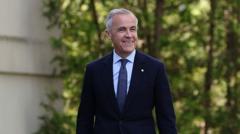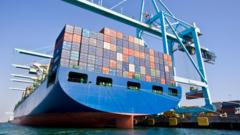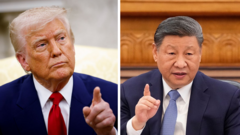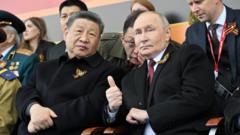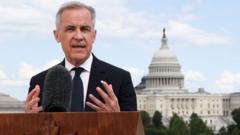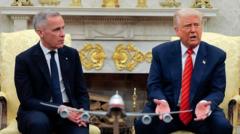Honda's decision to move CR-V production from Canada to the U.S. and postpone electric vehicle investments poses significant challenges for Canada's new Prime Minister Mark Carney amid ongoing U.S. tariffs, which have affected multiple automakers in the country.
Honda Shifts SUV Production from Canada to U.S. Amidst Tariff Challenges

Honda Shifts SUV Production from Canada to U.S. Amidst Tariff Challenges
U.S. tariffs prompt Honda's relocation of CR-V production to America, impacting Canada's electric vehicle investments.
In a significant move shaped by the economic landscape defined by U.S. tariffs, Honda has announced it will relocate the production of its CR-V sport utility vehicle from Ontario, Canada, to its facilities in the United States. This decision, revealed on Monday, comes along with the postponement of an ambitious $11 billion investment plan for electric vehicle and battery manufacturing in Canada.
This announcement follows Honda's previous denial of reports suggesting that tariffs imposed by the U.S. government could impact its Canadian operations. President Trump’s trade policies, which include a substantial 25 percent tariff on numerous Canadian auto imports, have continued to strain relations and economic activities between the two countries, particularly impacting Canada’s automotive sector.
Honda's CEO, Toshiro Mibe, described the shift in production as a necessary step to "optimize" operations in light of these tariffs. He cited a slowdown in the electric vehicle market as a critical factor behind Honda's postponement of the expansive project, which was hailed by former Prime Minister Justin Trudeau as the largest investment in Canadian automotive history. This investment had promised to create approximately 1,000 jobs and was part of a broader strategy to pivot Canada's auto industry towards electric mobility.
While the immediate impact of Honda's production move remains uncertain, industry observers note that the majority of vehicles assembled in Canada are destined for the U.S. market. Honda employs around 4,200 workers at its Alliston, Ontario plant, which also produces Civic sedans and engines.
The challenges presented by Honda's announcement are particularly pressing for Prime Minister Mark Carney, who recently assumed office with a reputation for being adept in handling trade conflicts with the United States. As Carney prepares to form his administration, he faces mounting pressure from the automotive sector, which has seen a series of retrenchments since the onset of tariffs.
Among those affected, Stellantis has paused the conversion of its Toronto-area facility for electric and gasoline Jeep production, while General Motors suspended the assembly of an electric commercial van in Ontario. Ford's Oakville plant has remained inactive for nearly a year following the abandonment of electric vehicle production plans.
As Carney works to navigate these challenges, the implications of these corporate decisions underscore the urgent need for strategic economic planning and bilateral trade negotiations to stabilize and grow Canada’s automotive industry in this turbulent landscape.
The full effects of these industry shifts will unfold as Honda and other automakers reassess their positions in the market amidst evolving economic policies and trade dynamics.
This announcement follows Honda's previous denial of reports suggesting that tariffs imposed by the U.S. government could impact its Canadian operations. President Trump’s trade policies, which include a substantial 25 percent tariff on numerous Canadian auto imports, have continued to strain relations and economic activities between the two countries, particularly impacting Canada’s automotive sector.
Honda's CEO, Toshiro Mibe, described the shift in production as a necessary step to "optimize" operations in light of these tariffs. He cited a slowdown in the electric vehicle market as a critical factor behind Honda's postponement of the expansive project, which was hailed by former Prime Minister Justin Trudeau as the largest investment in Canadian automotive history. This investment had promised to create approximately 1,000 jobs and was part of a broader strategy to pivot Canada's auto industry towards electric mobility.
While the immediate impact of Honda's production move remains uncertain, industry observers note that the majority of vehicles assembled in Canada are destined for the U.S. market. Honda employs around 4,200 workers at its Alliston, Ontario plant, which also produces Civic sedans and engines.
The challenges presented by Honda's announcement are particularly pressing for Prime Minister Mark Carney, who recently assumed office with a reputation for being adept in handling trade conflicts with the United States. As Carney prepares to form his administration, he faces mounting pressure from the automotive sector, which has seen a series of retrenchments since the onset of tariffs.
Among those affected, Stellantis has paused the conversion of its Toronto-area facility for electric and gasoline Jeep production, while General Motors suspended the assembly of an electric commercial van in Ontario. Ford's Oakville plant has remained inactive for nearly a year following the abandonment of electric vehicle production plans.
As Carney works to navigate these challenges, the implications of these corporate decisions underscore the urgent need for strategic economic planning and bilateral trade negotiations to stabilize and grow Canada’s automotive industry in this turbulent landscape.
The full effects of these industry shifts will unfold as Honda and other automakers reassess their positions in the market amidst evolving economic policies and trade dynamics.

